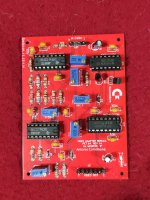Hi Hugo.
Somewhere in the 1,537 posts of this thread we did take a trace of the input to the new video board (which is the same point as the output from the C64).
I have given Desperado the job of searching for the requisite image because I am too busy at the moment.
EDIT: OK, I found a couple:
Post #532 on page #27 of the thread.
Post #653 on page #33 of the thread.
One is better (height wise) than the other - but the oscilloscope is not synchronised to the signal so it has a few ghosts...
Dave
Dave, those Oscillograms show line rate recordings. We need to see a signal in the vertical sync interval to show at least 5 or 10 lines or so around the vertical sync.
One problem in this whole project is that we never got to see the way the H sync pulses behaved during the vertical interval in the C64 signal.
If it was just standard NTSC style , but monochrome video, I could guess, but in Computers they did all sorts of things to it, knowing that the VDU's scan oscillators would gloss over it.
Clearly the C64 was designed to feed a style of VDU that had independent scan oscillators, and these are very very forgiving. They don't care if the H sync pulse vanishes during the V sync pulse.
The thing is though, Desperado is trying to drive the 9" VDU that requires very specific drive waveforms to make it work.
Specifically, the H drive wave which requires a drive signal of the correct frequency and duty cycle and completely un-interrupted by any glitches in the vertical block. This is why he had that odd problem of the Bumble Bee buzz.
The original Commodore circuit we have been struggling with, was definitely designed to feed a VDU which had its own H scan oscillator and locked to the H sync pulse. (Unlike the unique 9" VDU). The PLL nature of the 12" VDU in the H scan oscillator, smoothed out any errors in the vertical sync interval.
But , he/we have tried to re-task the Commodore circuit for the 9" VDU. When, it might have been better to start with a different design concept for the task.
Still we may be able to get what he now has to work, as at least all the essential elements are now present on the board.
But I cannot make a lot of sense out of it unless I could see a conventionally drawn schematic and the actual video signal driving it in the vertical interval. Then I could predict what waveforms/signals should be present at each point on the circuit.


